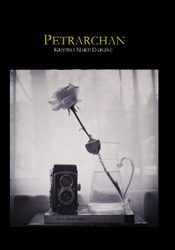
Released this past February by BlazeVOX Books, Kristina Marie Darling’s Petrarchan continues the poet’s study in footnotes and fragments. Don’t expect to find neatly arranged stanzas here; rather, Darling prefers to tell her love story in broken-apart thoughts, small but vivid details and ample white space.
As its title suggests and the author’s notes confirm, Petrarchan is a work in dialogue with the famous Italian writer of sonnets. The chapter titles are taken from Petrarch’s bibliography, and the appendices are composed using only found text from Petrarch’s sonnets. Darling also mentions Anne Carson’s translation of Sappho as an inspiration. In a May 2013 interview with Word Riot, Darling talks about the role these source materials played in writing Petrarchan:
I feel like all poetry arises from the writer’s life as a reader. I think of poetry as a conversation, in which the poet appropriates, revises, and recasts what has been said before her. But with Petrarchan, there was more of a “thesis” than with my previous projects. I love Petrarch’s work, but it’s so problematic for me as a female reader. His writing, perhaps more than any other one person’s work, has been associated with the male gaze, the silenced beloved, and various master narratives about what love should or ought to be. Petrarchan is my attempt to reconcile Petrarch’s sonnets with my enduring interest in feminist reading practices.
But while Petrarchan does indeed wrestle with the problematic romantic ideal put forth by Petrarch, the reader doesn’t need to be well versed in Petrarchan sonnets and surrounding literary theory to connect with this writing. Petrarchan doesn’t even require that its reader be well versed in Darling’s own oeuvre (the prolific poet has released several books in the last few years), although it helps—Darling remains as much in dialogue with her past work as with the work of other writers.
The characters we follow throughout Petrarchan—she, he, the house, the sea—are all introduced right at the start of the book’s first section and are all familiar subject material for Darling. We begin with a “marble staircase, which he had cordoned off with a white ribbon.” Such specificity (marble staircase, white ribbon) offers the reader necessary concrete somethings to hold onto, as we are immediately also presented with vast terrain, shifting floorboards and locked doors. The first “definition” we are given is for the word instability:
Instability.
1. A tendency toward unpredictable behavior.
2. A fast growing disturbance or wave in a body of water.
We sense at the start that this love story will be a turbulent one, and that the ending will likely be unhappy. Indeed, “excavation can be an unforgiving task” and the “smallest disturbance seemed to devastate the ocean’s pristine shore.”
As we move through the sections of Petrarchan, we accumulate details: pale hands and fragile wrists, the little silver key, the golden clasp, tiny silver bells, a heap of charms and unsightly pearl earrings, her beloved’s black winter coat. And as these details pile up, a narrative emerges. The golden clasp becomes a broken clasp, “which he sent to a nearby jeweler for repair.” Later, there is a “brief note from the jeweler, in which he told her that this trinket was shattered beyond repair.” Darling continues to demand that her reader be an active one; her reader must be willing to engage with and participate in the drama unfolding. We must piece together the fragments ourselves in order to “understand this house by the sea, its faultless architecture.”
There is also misdirection: We are referred to non-existent appendices, maps and elaborations. There is mention of a documentary that “follows a woman through of a session of psychoanalysis, in which she refers to the conscious mind as her ‘house by the sea.’ The film reveals her fictive ‘beloved’ as the source of this enduring euphoria.” A page later, a footnote references a late nineteenth-century novel “in which the heroine was known to fabricate mementos.” Perhaps the narrative is not a straightforward love story after all. Perhaps the clues and details do not add up. If our heroine is not to be trusted, can we rely on the evidence Darling’s footnotes offer up? What of “the photographic documents each of the tiny marks found at the back of her lustrous white neck” and the aforementioned note from the jeweler, confirming the existence of the broken clasp?
I’m not sure it matters much what is real here and what is imagined. Like any true love story, this one is complicated. It’s only partially revealed to us; much of the narrative remains clouded in the white space above the footnotes. Function follows form here—we can only grasp certain pieces of information one at a time, and must move quickly onto the next, not necessarily related, piece of information. Much of my enjoyment in reading Darling comes from this setup of pacing that is at the same time fragmented and fast.
Petrarchan closes with the two appendices I mentioned up top, comprised entirely of found text from Petrarch’s sonnets. Here Darling abandons the shape of the rest of the book. Gone are the footnotes set below a near-empty white page. But she can’t quite bring herself to abandon white space entirely: The first appendix contains words and phrases set apart by white space, and the second appendix contains fewer words within its confounding sets of brackets than empty lines. Again, it’s what isn’t said that carries the most weight.




